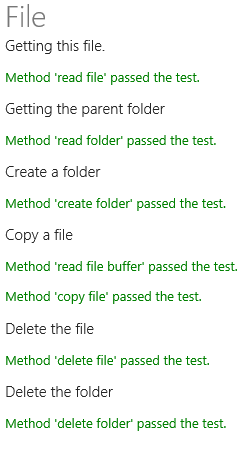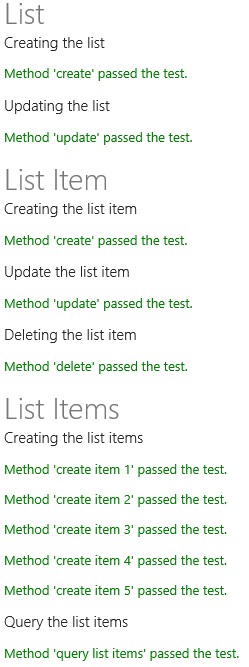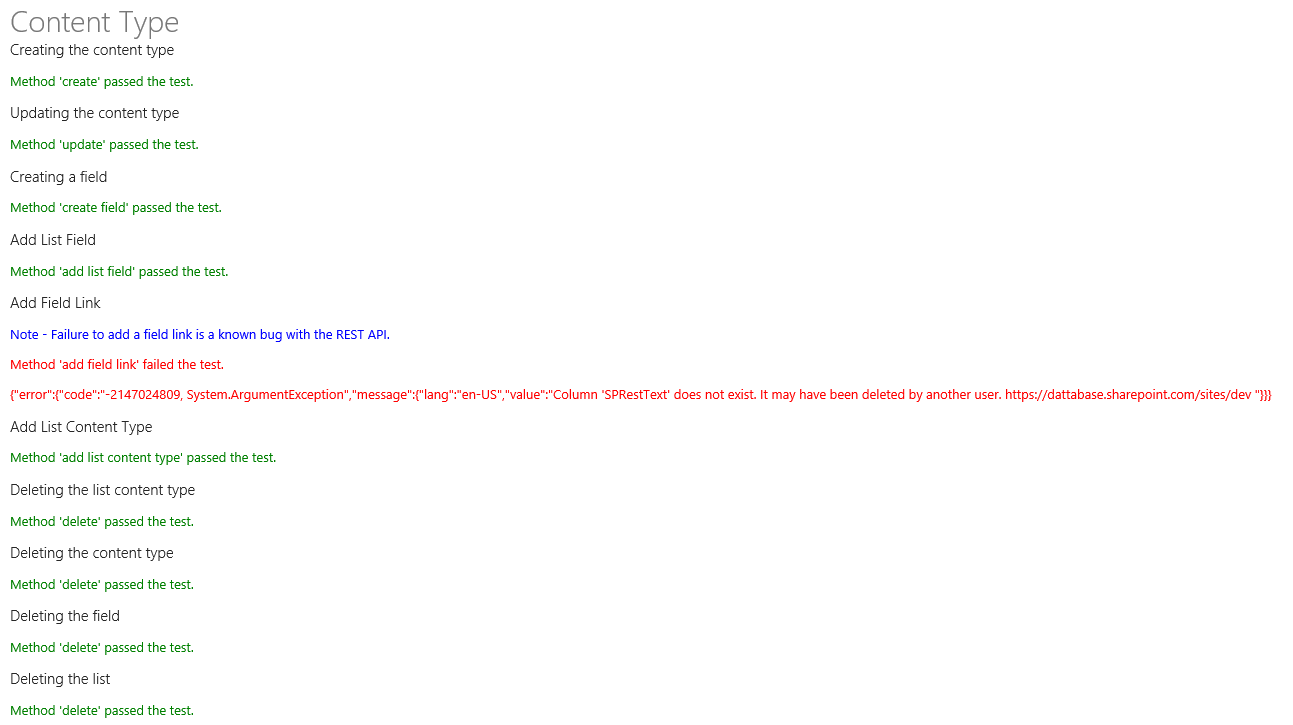SharePoint 2013/Online REST Library
An easy way to develop against the SharePoint REST api.
This library is still being tested...
Please report issues. I am constantly updating/fixing/testing to make this library better.
Benefits:
- Generates the REST api url and formats it for app webs automatically.
- Global flag to execute requests on creation, to reduce the number of calls to the server.
- Parent property for easier development.
- PowerShell-Like experience in the browser console. (Synchronous Requests)
- Switch between asynchronous and synchronous requests by the object's property.
- Written in TypeScript.
Get Started:
Node Package Manager (NPM)
npm install gd-sprest --save-dev
Example Projects
Bootstrap List
Documentation:
Executing Requests from the App Web
A global flag is used to determine if an app web request should execute requests against the host web. The host web will default to the SPHostUrl query string value.
Note - This value is false by default
$REST.DefaultRequestToHostWebFl = true;
Asynchronous/Synchronous requests
All objects have the following constructors [Object] and [Object]_Async.
Examples
Asynchronous Request
new Web_Async(function(web) { ... });
Synchronous Request
var web = new Web();
Execute on Creation
A global flag is used to determine if the request should be executed on creation. This option can save a request to the server.
Note - This value is true by default.
$REST.ExecuteOnCreationFl = false;
Fewer Requests to the Server
Having the execute on creation boolean option, if set to false will construct the url of the base object without making a request to the server.
Example - Creating a List
Synchronously
// This will create the web object, but not execute the request.
var web = new $REST.Web(false);
// This will execute the request to create a list
var list = web.addList({
BaseTemplate: 100,
Description: "This is a test list.",
Title: "Test"
});
Asynchronously
// This will create the web object, set the asynchronous flag and not execute a request to the server
(new $REST.Web_Async(false))
// This will execute a request to the server to create a list
.addList({
BaseTemplate: 100,
Description: "This is a test list.",
Title: "Test"
})
// This will execute after the list is created
.done(function(list) {
// Additional code goes here
});
Example - Query a List
// This will execute one request to the server to get list items
// new $REST.ListItems("[List Name]", "[View XML or CAML Query]");
// The query will default the parent to "<View>"
new $REST.ListItems("Site Assets", "<Query><Where><Gt><FieldRef Name='ID' /><Value Type='Integer'>0</Value></Gt></Where></Query>");
new $REST.ListItems("Site Assets", "<View Scope='RecursiveAll'><Query><Where><Eq><FieldRef Name='FileLeafRef' /><Value Type='File'>sprest.js</Value></Eq></Where></Query></View>");
Optional Input
All constructors take have the following optional parameters:
// The target information and execute request flags are optional
new Object([Object Specific Input Parameters], executeRequestFl);
new Object([Object Specific Input Parameters], targetInfo);
new Object([Object Specific Input Parameters], targetInfo, executeRequestFl);
// Asynchronous methods can take either a target information object, or the callback function
new Object_Async([Object Specific Input Parameters], targetInfo, executeRequestFl);
new Object_Async([Object Specific Input Parameters], function(obj) { ... }, executeRequestFl);
Target Information
The target information consists of the following properties:
- asyncFl - Flag to determine if the request should executes asynchronously or synchronously.
- bufferFl - Flag to determine if the output of the request is a file stream.
- callback - Required for asynchronous request. Executed after execution.
- data - Template used for passing the method parameters in the body of the request.
- defaultToWebFl - Flag to determine if the url should default to the current web url, site url otherwise.
- method - The request method type.
- endpoint - The api endpoint.
- url - The server relative site/web url to execute the request against.
Execute Request Flag
The executeRequestFl parameter will default to the global $REST.ExecuteOnCreationFl value.
PowerShell-Like Experience
Since the library can be executed synchronously, the user can execute commands in the browser's console window and interact with the SharePoint site in a command-line interface.
Note - The commands will execute under the security of the current user.
Note - SharePoint online may reject synchronous requests. It's better to use asynchronous requests.
Test:
To test this library, upload the test folder contents to a SharePoint library and access to the "test.aspx" page. This will test the basic functionality of the library.
Refer to the test script file for detailed examples of using the library.
File/Folder

List/Item

Content Type/Field

Examples:
Note - The examples below will execute one request to the server.
Content Type
List
new $REST.ContentTypes("Document", "documents");
Web
new $REST.ContentTypes("Document");
Content Types
List
new $REST.ContentTypes("documents");
Web
new $REST.ContentTypes();
Field
List
new $REST.Fields("Title", "documents");
Web
new $REST.Fields("Title");
Fields
List
new $REST.Fields("documents");
Web
new $REST.Fields();
File
List
Asynchronously
// This will get the Forms subfolder of the documents library, set the asynchronous flag, and not execute request
new $REST.Folder_Async("Forms", "Documents", false)
// This will get the file asynchronously
.getFile("EditForm.aspx")
.done(function(file) {
// Code executes after we have the file object
});
Synchronously
// This will get the file synchronously
new $REST.File("sprest.js", "documents");
Web
new $REST.File("/sites/dev/shared documents/forms/EditForm.aspx");
Files
List
new $REST.Files("documents");
Web
new $REST.Files();
Folder
List
new $REST.Folder("sprest.js", "documents");
Web
new $REST.Folder("/sites/dev/shared documents/sprest.js");
Folders
List
new $REST.Folders("documents");
Web
new $REST.Folders();
List
new $REST.List("documents");
Lists
new $REST.Lists();
List Item
new $REST.ListItems(1, "documents");
List Items
All Items
new $REST.ListItems("documents");
CAML Query
new $REST.ListItems("documents", "<Query><Where><Gt><FieldRef Name='ID' /><Value Type='Integer'>0</Value></Gt></Where></Query>");
Role Assignments
List
new $REST.RoleAssignments("documents");
Web
new $REST.RoleAssignments();
Role Definitions
new $REST.RoleDefinitions();
Site
new $REST.Site();
Site Groups
new $REST.SiteGroups();
User Custom Actions
Site
new $REST.UserCustomActions();
Web
new $REST.UserCustomActions(true);
Users
new $REST.Users();
View
new $REST.View("all items", "documents");
Views
new $REST.Views("documents");
Web
new $REST.Web();






